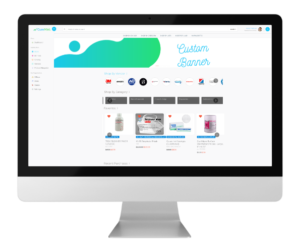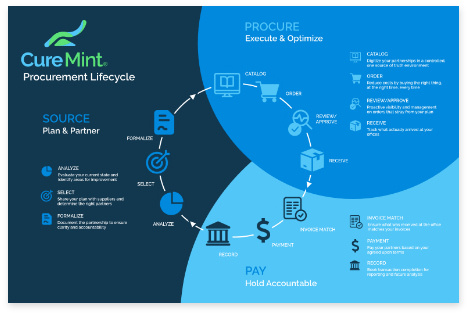At CureMint, we’re committed to driving down costs as we help your dental organization reshape its supply procurement strategy. In this blog series, we’ll guide you through nine easy steps to drive down your dental supply expenses so you can better manage your finances and become more profitable in the dental industry.
The heavy lifting of our nine-step process may have concluded, but as we said in Step 7, your work has just begun. Sure, you’ve laid the groundwork for big-time savings on your dental organization’s supply costs, but now, you’re sending your new formulary out into the world — in other words, into the hands of your staff. What good is all the work you’ve done if no one follows the new standards?
In this penultimate portion of our nine-step process, we’ll teach you how to easily track and manage your supply expenses so that your hard work will not have been in vain.
STEP 8: TRACK & MANAGE COMPLIANCE WITH CUREMINT
Each office in your dental organization must follow your formulary guidelines and purchase the products approved by your clinical trials in order to appropriately realize savings driven by your negotiations and consolidations. Compliance may be low at first, but don’t let that discourage you. But simply informing clinical staff that a product has been moved off the Primary Formulary won’t have much of an effect on ordering habits. Of course, we have a few tips to improve and ensure compliance with the new formulary.
You need to be able to evaluate an office’s supply orders and confront them when staff strays from the formulary, but you also want to grant some autonomy for unusual, one-off products, or special products for certain staff members. One very helpful tip for striking this balance is to establish formulary adherence rules. These rules may be fluid for each organization, or even among general dentists and specialists.
Perhaps the most common rule we’ve witnessed is what we’ll call the “85-10-5” Rule: 85% of an office’s supply expenses can be allocated to the Primary Formulary, while 10% may be allocated to the Secondary Formulary and 5% may be allowed for off-formulary purchases when the need arises. Some organizations exclude the 5% off-formulary spending, whereas other offices like to give their doctors more than 15% supply autonomy. Regardless of exactly where you might land with your proportions, it’s an easy rule to remember and provides ample leeway for discretionary spending.
Another way to establish clinical compliance among your offices is to enact a “carrot-and-stick” approach for financial responsibility. For a “carrot” example, organizations could reward doctors with monthly bonuses equal to, say, 50% of the difference between their budgeted supply expenses and actual expenses. If you wanted to implement a “stick” when and if an office overspends, you could say that doctors are financially responsible for any off-formulary purchases over 5%, or 50% of any secondary formulary purchases over 10%. Of course, you should come up with your own “carrot-and-stick” model that best fits your company’s culture and staff.
At this point, you ask, “How can you track and manage spending?” You could track formulary compliance and spend through our old friend, the Excel spreadsheet, but that’s very difficult to maintain. We recommend a procurement-system software — namely, CureMint.
 CureMint is an intuitive procurement software built specifically for dental organizations. CureMint allows you to digitize all of your suppliers, products, and pricing on your own personal Amazon of an online catalog, all conveniently segmented into an unlimited number of formularies. These functions provide you with the ability to track key data points, such as what percentage an office is ordering from which formulary, as well as build custom approval workflows to proactively bring to your attention any offices straying from the formulary plan. CureMint makes it easy to change and consolidate products on specific formularies, so when offices go to order supplies in the tool, the formularies appropriately match the trials and consolidations performed thus far. Not only can you more easily track compliance; it’s just simpler for your offices to order in a compliant manner with CureMint.
CureMint is an intuitive procurement software built specifically for dental organizations. CureMint allows you to digitize all of your suppliers, products, and pricing on your own personal Amazon of an online catalog, all conveniently segmented into an unlimited number of formularies. These functions provide you with the ability to track key data points, such as what percentage an office is ordering from which formulary, as well as build custom approval workflows to proactively bring to your attention any offices straying from the formulary plan. CureMint makes it easy to change and consolidate products on specific formularies, so when offices go to order supplies in the tool, the formularies appropriately match the trials and consolidations performed thus far. Not only can you more easily track compliance; it’s just simpler for your offices to order in a compliant manner with CureMint.
With your compliance guidelines and CureMint in place, you might be thinking, “Finally! My work here is done!” But you can’t wash your hands of responsibility just yet. Cutting supply costs requires constant vigilance to always find the best deals… but we’ll save that for our last installment.
Keep a lookout for Part Nine: Rinse, Repeat, & Save in the Future
Can’t wait for the next blog? We don’t blame you! Download the full guide to get immediate access to our last Step.
Related Blogs
Dental Procurement vs. Dental Supply Purchasing: What’s the Difference?
11.02.21
As dental practice owners and office managers look into their…
How to Get Started with Dental Spend Management When You Don’t Know Where to Start
09.30.21
For rapidly growing dental service organizations (DSOs), the…
Using Big Data to Lower Dental Supply Costs
09.28.21
As the dental market surpasses $150 billion and private…





